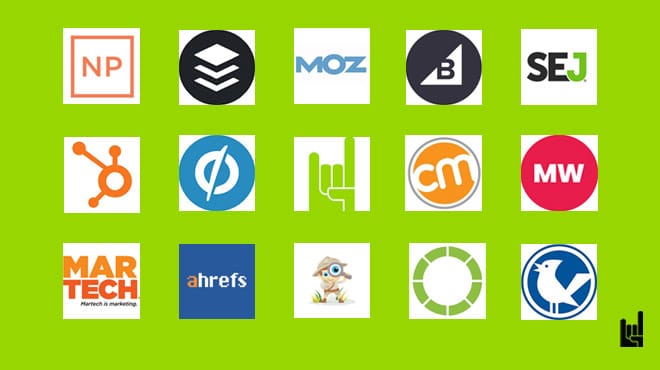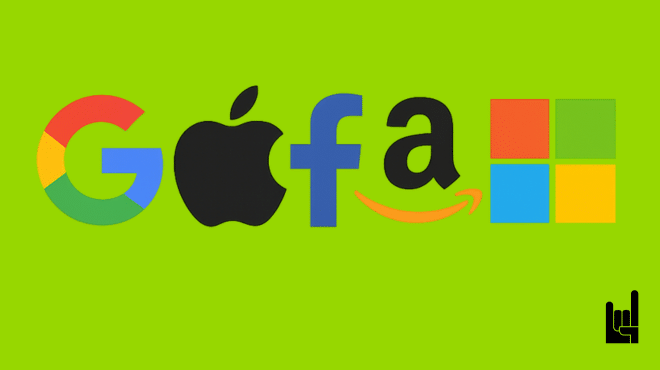Intro
Link-in-bio pages are essential tools for social media users, influencers, and businesses to maximize their online presence. Although Instagram now allows more than one clickable link in the bio, these links are not dynamic and may not meet all your needs. Link-in-bio pages provide a single, customizable landing page that houses multiple links, enabling users to direct their audience to various content, such as blog posts, products, social media profiles, and more, from a single URL. This approach enhances user engagement and streamlines the navigation experience, making it easier for followers to access the information and resources you want to share.
The link-in-bio tools
The link-in-bio tools and services category has become essential in the digital landscape, especially for social media users, influencers, content creators, and businesses aiming to maximize their online presence.
These platforms are versatile solutions for consolidating multiple links into a single, accessible landing page, enabling users to effectively direct their audience to various content, products, and services.
From traditional players like Linktr.ee, known for their simplicity and reliability, to more specialized options like Flodesk, which excels overall with its robust design and functionality, and Tap Bio, which stands out for its card-like link display, the range of offerings is vast.
Some platforms, like Lnk.Bio, cater to those needing unlimited link posting, while others like ShortStack focus on enhancing engagement through interactive content such as contests. Shorby emphasizes direct communication with visitors, and Taplink integrates payment options seamlessly.
For e-commerce, Linkin.bio by Later converts social posts into shopping links, whereas Campsite.bio allows for extensive customization for brand alignment. Instapage integrates ad campaigns with landing pages for marketers, and Bio.fm offers a comprehensive approach, including various media types alongside links.
The (almost) complete list
Each platform addresses unique needs, making the link-in-bio category diverse and adaptable to different digital strategies.
- Linktr.ee: Linktr.ee is a pioneering link-in-bio platform that allows users to create a simple, customizable landing page for all their essential links. It offers basic features with an intuitive interface, making it easy to use and widely recognized.
- Flodesk: Flodesk is a comprehensive platform known for its beautiful design and user-friendly interface. It provides a robust set of features for link-in bio pages, including customizable templates, analytics, and integration with email marketing tools, making it an excellent choice overall.
- Tap Bio: Tap Bio stands out with its unique card-based design, which allows users to present links in an engaging and visually appealing manner. This approach is particularly effective for storytelling and showcasing different types of content.
- Lnk.Bio: Lnk.Bio allows you to add an unlimited number of links to your bio page, making it ideal for users who need to share a large amount of content. It is straightforward and flexible, catering to those with extensive link-sharing needs.
- ShortStack: ShortStack specializes in creating interactive content such as contests, quizzes, and giveaways. It integrates these features seamlessly into the link-in-bio page, boosting user engagement and participation.
- Shorby: Shorby focuses on direct communication, offering tools that make it easy for visitors to contact you via various messaging platforms directly from your link-in-bio page. It’s perfect for businesses and influencers who prioritize direct interaction with their audience.
- Taplink: Taplink excels at integrating payment options directly into your link-in-bio page. It supports multiple payment methods, making it convenient for users to receive payments for products, services, or donations.
- Linkin.bio by Later: Linkin.bio by Later is designed to turn Instagram posts into clickable links, facilitating easy shopping directly from social media. It’s a powerful tool for e-commerce businesses looking to drive sales through their social media presence.
- Campsite.bio: Campsite.bio offers extensive customization options, allowing users to create a link-in-bio page that reflects their brand’s unique aesthetic. It’s ideal for those who want a tailored and professional-looking landing page.
- Instapage: Instapage is known for its seamless integration with ad campaigns. It provides advanced features for creating and optimizing landing pages that align with advertising efforts. It’s a top choice for marketers looking to maximize their ad performance.
- Bio.fm: Bio.fm is versatile, allowing users to share a wide range of content beyond just links. It supports various media types, making it a great option for users who want to publish detailed information, such as bios, videos, and social media feeds, all in one place.
What do these platforms do?
These platforms offer a centralized hub for your most important links, making navigating and engaging with your content easier for your audience. Additionally, many of these tools provide valuable features such as analytics, customization, and integration with other platforms, which can enhance your online engagement and marketing efforts. However, if you do not rely heavily on directing traffic from social media or if a single link to your website suffices for your needs, you might not find it necessary to use these tools. Ultimately, the decision hinges on your specific online presence and marketing requirements.
Do you need them?
While link-in-bio tools offer many conveniences, notable cons can make them less appealing for some users.
Firstly, the results of most of these platforms are off-brand, meaning they may not fully align with your unique brand identity and aesthetics, potentially causing a disconnect for your audience.
Secondly, because these tools are hosted externally, all valuable metrics, such as pixels, affiliate traffic, and referral traffic, do not contribute to your web property. This results in “lost” traffic that doesn’t bolster your own website’s analytics.
Additionally, these tools often lack the dynamism required to keep up with your evolving content needs, such as automatically updating with your latest posts or free guides.
Lastly, many link-in-bio platforms do not support the creation of multiple pages, limiting your ability to organize and present content in a more comprehensive and structured manner. These limitations can be significant drawbacks for users who need more control and integration with their digital marketing efforts.
There is an elephant in the room, and that’s a security concern. One major issue when using third-party link-in-bio tools is the security risk they pose. When your users click the link-in-bio link, they must always consent to cookies at their first click. As you can assume, these are not your cookies but those of a third party, which can raise privacy concerns and potentially expose user data to external entities without their full awareness. This can undermine trust and compromise the security of your audience’s information.
Dear DPOs, did you ever checked the cookie consent, your users are giving to the link-in-bio pages? Is it documented in your privacy policy or data governance policies you maintain?
What’s the alternative?
If your website runs on WordPress, creating a custom Instagram-like page for your link-in-bio can be a superior choice.
Firstly, a custom WordPress page allows you to maintain full control over your branding, ensuring that the page’s look and feel align perfectly with your brand identity. You can customize the design, layout, and functionality to match your unique style and requirements.
Secondly, hosting the page on your own domain means that all traffic, including affiliate and referral traffic, contributes directly to your website’s analytics. This lets you capture valuable metrics and insights without losing data to external platforms.
Additionally, WordPress offers dynamic content capabilities, enabling you to easily update the page with your latest posts, free guides, and other content, ensuring it remains current and relevant. Moreover, with WordPress, you can create multiple pages if needed, providing greater flexibility to organize and present your content.
By leveraging WordPress’s power, you gain more control, better integration with your existing digital strategy, and a seamless, branded experience for your audience.
Is convenience your concern?
While creating a custom page on WordPress offers many advantages, it’s important to acknowledge that dedicated link-in-bio apps can provide a level of convenience that might be hard to match. Here are a few points to consider regarding the convenience of these simple apps:
- Ease of Setup: Link-in-bio apps are designed to be user-friendly and quick to set up. You can typically create a functional page in minutes without needing technical skills. In contrast, building and customizing a WordPress page may require more time and familiarity with the platform.
- Maintenance-Free: These apps handle all the backend maintenance, security updates, and performance optimization. With WordPress, you need to ensure your site is secure, updated, and running smoothly, which can be time-consuming.
- Built-in Features: Many link-in-bio apps come with built-in features such as analytics, link tracking, and integrations with social media platforms, which are ready to use out of the box. Implementing similar features on a WordPress page might require additional plugins and configurations.
- Mobile Optimization: These apps are often optimized for mobile users, ensuring a seamless experience across devices. While WordPress can also be optimized for mobile, it requires careful design and testing to ensure the page looks and functions well on all devices.
- Support and Updates: Link-in-bio apps offer customer support and regularly update their features based on user feedback. With WordPress, while there is a large community and many resources, finding support for specific issues might take more effort.
- No Hosting Concerns: Using these apps means you don’t need to worry about hosting issues, such as uptime, server performance, or scalability. With WordPress, you must manage these aspects, especially if your site experiences high traffic.
Is it only for traffic coming from Instagram?
No, link-in-bio tools are not exclusively for traffic coming from Instagram. While they are highly popular and effective for Instagram due to its limitation of only one clickable link in the bio, these tools can be used across multiple platforms. Here’s how they apply to different traffic sources:
Other Social Media Platforms: Link-in-bio tools can be used on any social media platform that allows a single bio link. This includes platforms like TikTok, Twitter, LinkedIn, Pinterest, and Facebook. You can efficiently direct traffic from various social media profiles to all your important content and links by providing a centralized landing page.
Email Marketing: You can include the link to your link-in-bio page in email signatures or marketing campaigns. This allows recipients to access your most relevant links and resources easily, driving engagement beyond just social media.
Business Cards and Print Media: Including a QR code created with a QR code generator or a short URL on business cards, flyers, or other print media that leads to your link-in-bio page can streamline access to your online presence.
Blog Posts and Articles: Embedding the link-in-bio URL within blog posts or online articles can allow readers to explore more of your content or offerings without cluttering the article with multiple links.
Profile Links on Various Online Platforms: If you are active on forums, community sites, or any other online platforms that allow a profile link, using a link-in-bio URL can be an effective way to share your multiple resources and contacts.
Video Descriptions: For video content on platforms like YouTube, including a link-in-bio URL in the description can direct viewers to your other social media profiles, products, services, and more.
The visual aspect
When designing a link-in-bio page to ensure it meets the highest user experience standards, it should be consistent, fast, and directly related to the content your audience expects to find upon clicking.
Consistency in design and branding is crucial, as it reassures visitors that they are in the right place and maintains your brand’s identity across platforms.
The page must load quickly, as slow load times can frustrate users and lead to higher bounce rates.
It’s important that the content is relevant and directly aligned with what the user is looking for, eliminating any confusion or frustration.
Additionally, the page should be free from popups, ads, or any intrusive content that can detract from the user experience. This keeps the focus on the links and content you want to share.
Most importantly, the page must be 100% responsive, providing an optimal viewing experience on all mobile devices. As 100% of the traffic will come from mobile users and those seeking the ultimate mobile experience, the design must adapt seamlessly to different screen sizes and resolutions, ensuring ease of navigation and accessibility. This approach ensures that your audience has a smooth, engaging, and satisfying experience whenever they visit your link-in-bio page.
Here are some Instagram-like examples (Remember: These are not Instagram feeds but web landing pages)
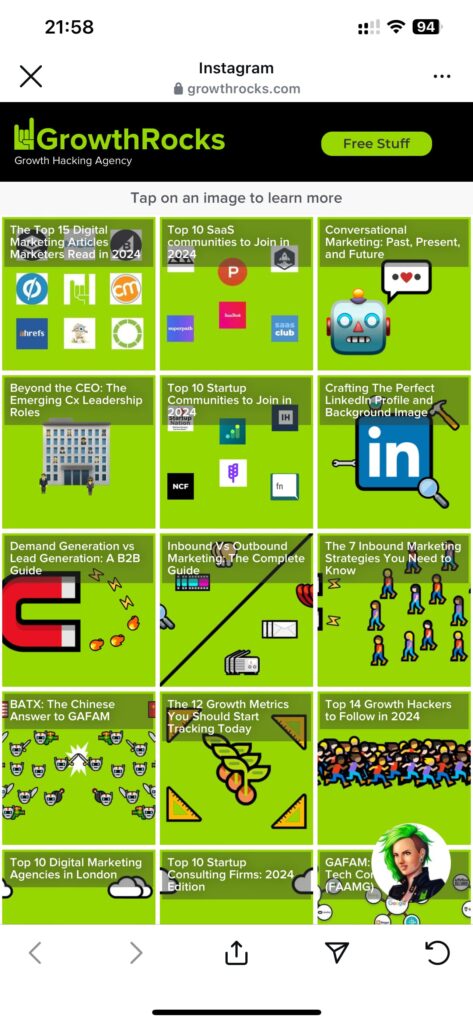

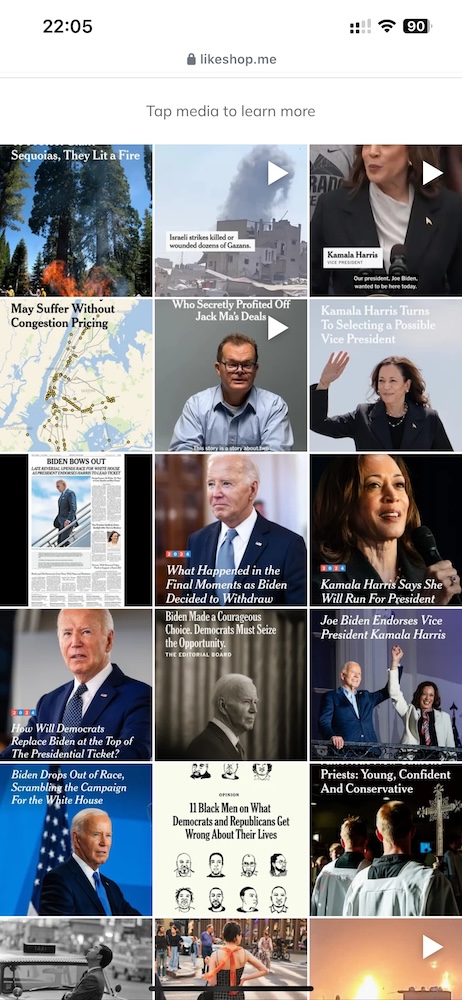
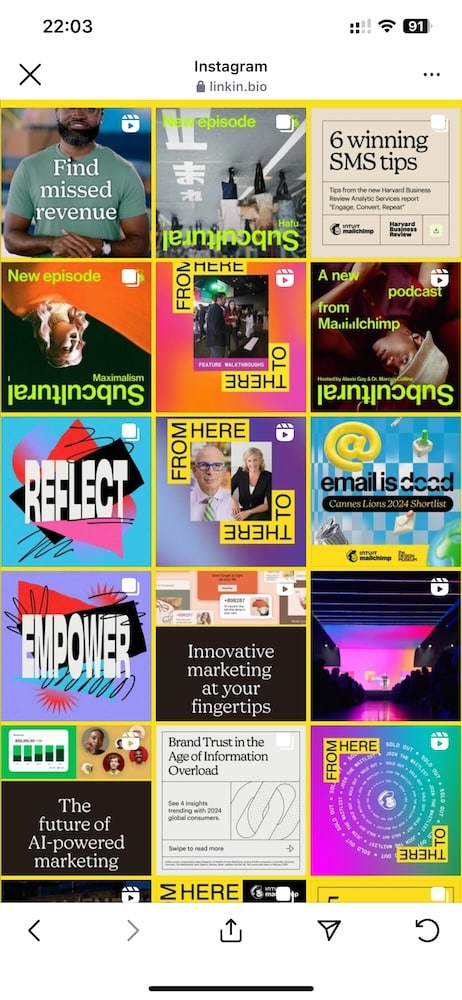


What content to select?
When deciding what content to include on your link-in-bio page, consider the type of content you regularly share and what your audience expects. For those with evergreen content that continually drives interest and traffic, consider featuring your latest articles, highlighted posts, or notable media cover articles. This keeps your audience engaged with your most valuable and enduring content.
If you frequently host webinars, courses, or events, dedicate a separate tab to “Upcoming Events.” This will make it easy for your audience to stay informed and register for your latest offerings. A well-organized layout with distinct sections will help users quickly find what they are looking for without sifting through irrelevant links.
Additionally, having a dedicated space for announcements, market news, or curated content can be extremely beneficial. This section can serve as a hub for all important updates and industry insights, keeping your audience informed and engaged with current happenings.
By categorizing your content into specific tabs like “Latest Articles,” “Upcoming Events,” and “Announcements,” you provide a structured and easy-to-navigate experience. This organization helps manage diverse content and ensures that your audience can effortlessly access the information most relevant to their interests and needs.
Outro
While link-in-bio tools offer convenience and functionality, weighing the security and branding concerns they present is essential. Fortunately, there’s always an alternative if you have a WordPress site. By creating a custom page on your own domain, you can maintain full control over your branding, data, and user experience, ensuring a seamless and secure journey for your audience. This approach allows you to customize every aspect to align perfectly with your needs, all while keeping your audience’s trust and privacy intact. Consider exploring this option to maximize the benefits of your digital presence.
Was this article useful?
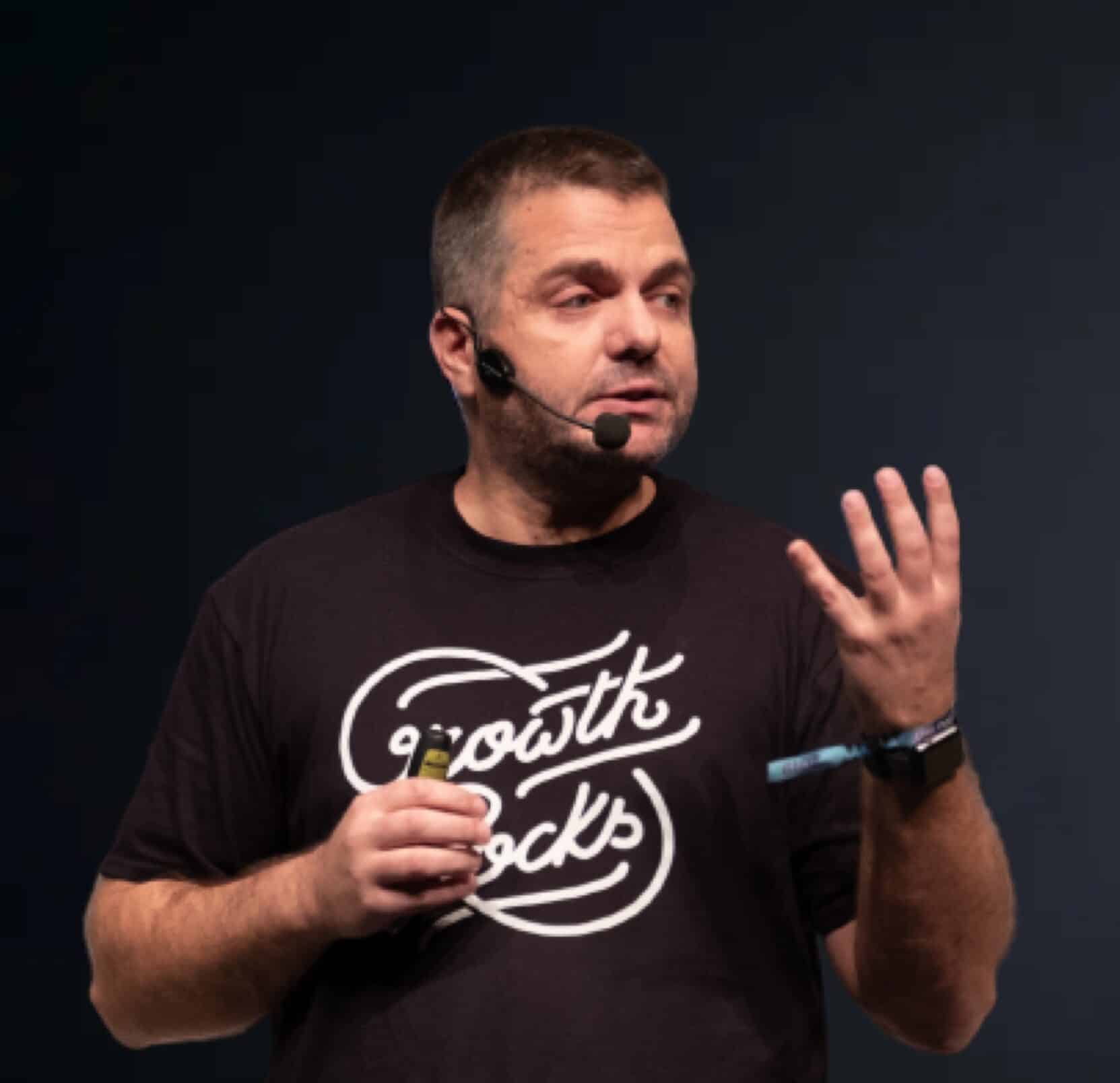
Theodore has 20 years of experience running successful and profitable software products. In his free time, he coaches and consults startups. His career includes managerial posts for companies in the UK and abroad, and he has significant skills in intrapreneurship and entrepreneurship.
